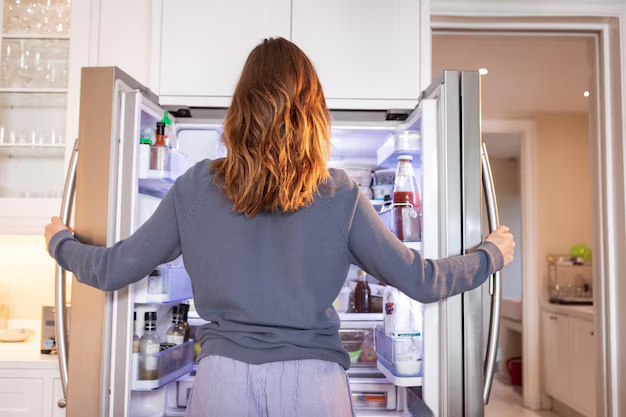Fast and Efficient: How to Defrost Your Refrigerator Quickly
Imagine this: You open your refrigerator's freezer to grab some frozen veggies for dinner, but you're met with a veritable iceberg lining the walls and crowding your food. Not only is this a nuisance, but it can also decrease your freezer's efficiency. The good news is, defrosting your refrigerator doesn't have to be a week-long ordeal. Let's dive into how you can defrost your refrigerator quickly and effectively, saving time and energy.
🥶 Why Frost Accumulates in Your Freezer
Before we explore the defrosting process, let's understand why frost accumulates in the first place. Frost or ice buildup occurs when warm, moist air enters the freezer, condenses, and then freezes. This can result from frequent door openings, improper sealing, or the ambient humidity in the kitchen. Over time, this frost builds up, reducing storage space and making it harder for the appliance to maintain a consistent, cold temperature.
Key Causes of Frost Buildup:
- Frequent door openings: Each time the door is opened, warm air rushes in, potentially leading to frost.
- Faulty door seals: If the gaskets around the door aren't sealing properly, warm air can constantly enter.
- Humidity levels: High kitchen humidity can lead to more condensation and subsequent frost.
🚀 Preparing for a Quick Defrost
Preparation is crucial to ensure the defrosting process is smooth and doesn’t spoil your food. Follow these preparatory steps:
- Plan Ahead: Choose a cooler day when you won’t be using the refrigerator as much. Avoid defrosting during intense heat to minimize the warm air affecting your fridge.
- Gather Supplies: You’ll need towels, basins for water collection, a spatula for ice removal, and bowls of hot water.
- Find Alternative Storage: Coolers with ice packs or borrow freezer space from a neighbor or friend for perishable items.
🛠️ Streamlined Steps to Defrost Your Refrigerator
1. Turn Off and Unplug
Power Off: Begin by turning off the refrigerator and unplugging it. This is the first crucial step in ensuring safety and stopping the compressor from adding more cold air, which thwarts the defrosting process.
2. Empty the Freezer
Sort and Store: Remove all food items. It’s wise to combine this with a quick inventory check to discard expired or unwanted items.
3. Speed Up the Process
If you're pressed for time, try these methods to accelerate defrosting:
Hot Water Bowls
Place bowls of hot water inside the freezer. The heat produced will swiftly melt the ice. Refresh the water as it cools to maintain effectiveness.
Use a Fan
A fan can increase air circulation. Set it up to blow warm air into the freezer. This can work in conjunction with the hot water method or stand alone.
Hairdryer
Exercise caution with this method. Use a hairdryer on its lowest setting to direct warm air over the ice. Keep the dryer at a safe distance to avoid water splashes and electrical hazards.
4. Remove Ice Fragments
Gently Tap Off Ice: Use a plastic or wooden spatula to avoid damaging the freezer walls. Gently dislodge large chunks as they loosen.
5. Clean and Sanitize
Wipe Down: As the ice melts, pools of water will form. Use towels to soak up the moisture and clean the freezer walls with a gentle, non-abrasive cleanser.
6. Dry and Reassemble
Air It Out: Allow the interior to fully dry. This prevents future frost buildup. Reorganize the freezer and plug the unit back in once you're satisfied it's dry.
🔧 Maintenance Tips to Minimize Future Frost Buildup
Defrosting shouldn’t be a frequent chore. By following some best practices, you can extend the time between defrosting sessions:
- Limit Door Opening: When accessing items, plan and open the door only for the necessary time.
- Seal Integrity: Regularly inspect the door seals and replace them if they show signs of wear or gaps.
- Temperature Control: Set your freezer to the manufacturer-recommended temperature, usually between -18°C to -15°C (0°F to 5°F).
- Balance Load: An overly packed freezer can restrict airflow, leading to uneven cooling and frosting.
🌟 Summary: Quick Tips for Efficient Defrosting
Here’s a quick-reference guide to ensure you remember the key points:
- 🗓️ Plan for a cool day: Schedule your defrosting when kitchen ambient temperatures are lower.
- ❌ Power off and unplug: Ensure safety by disconnecting from power.
- 📦 Temporary food storage: Use coolers or alternate freezers.
- 💦 Hot water bowls: Place them inside to melt ice quickly.
- ♨️ Fan or hairdryer: Blow warm air to aid defrosting, with caution.
- 🧼 Clean immediately: Prevent mess and sanitize the surface.
- 🧊 Dry thoroughly: Before restarting, ensure there’s no moisture left.
By incorporating these steps and maintenance tips, you’ll not only enhance the lifespan of your refrigerator but also improve its efficiency and keep food fresher longer. Remember, regular check-ups and mindful usage of your freezer reduce the chances of frost buildup and keep this task from becoming a recurring hassle. Happy defrosting!
